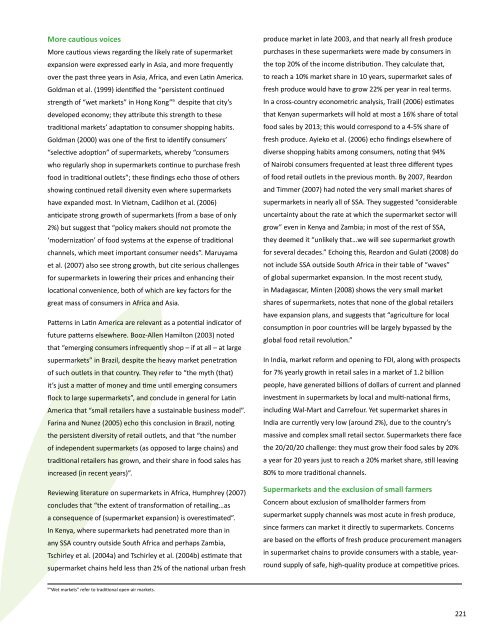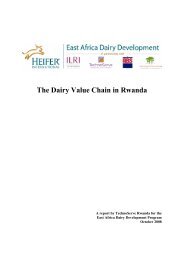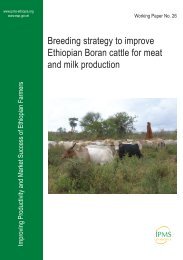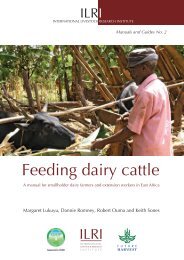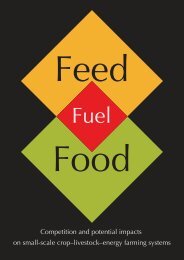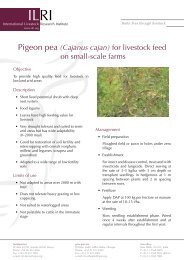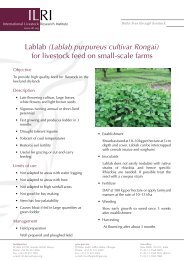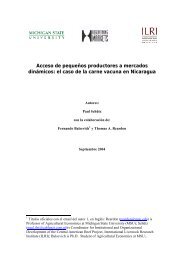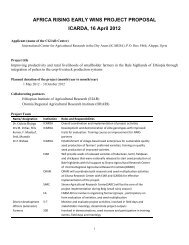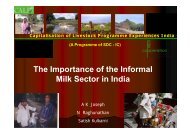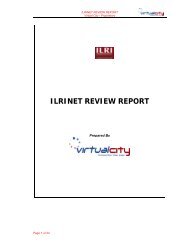High-Value Commodities and Agroprocessing - International ...
High-Value Commodities and Agroprocessing - International ...
High-Value Commodities and Agroprocessing - International ...
Create successful ePaper yourself
Turn your PDF publications into a flip-book with our unique Google optimized e-Paper software.
More cautious voices<br />
More cautious views regarding the likely rate of supermarket<br />
expansion were expressed early in Asia, <strong>and</strong> more frequently<br />
over the past three years in Asia, Africa, <strong>and</strong> even Latin America.<br />
Goldman et al. (1999) identified the “persistent continued<br />
strength of “wet markets” in Hong Kong” 9 despite that city’s<br />
developed economy; they attribute this strength to these<br />
traditional markets’ adaptation to consumer shopping habits.<br />
Goldman (2000) was one of the first to identify consumers’<br />
“selective adoption” of supermarkets, whereby “consumers<br />
who regularly shop in supermarkets continue to purchase fresh<br />
food in traditional outlets”; these findings echo those of others<br />
showing continued retail diversity even where supermarkets<br />
have exp<strong>and</strong>ed most. In Vietnam, Cadilhon et al. (2006)<br />
anticipate strong growth of supermarkets (from a base of only<br />
2%) but suggest that “policy makers should not promote the<br />
‘modernization’ of food systems at the expense of traditional<br />
channels, which meet important consumer needs”. Maruyama<br />
et al. (2007) also see strong growth, but cite serious challenges<br />
for supermarkets in lowering their prices <strong>and</strong> enhancing their<br />
locational convenience, both of which are key factors for the<br />
great mass of consumers in Africa <strong>and</strong> Asia.<br />
Patterns in Latin America are relevant as a potential indicator of<br />
future patterns elsewhere. Booz-Allen Hamilton (2003) noted<br />
that “emerging consumers infrequently shop – if at all – at large<br />
supermarkets” in Brazil, despite the heavy market penetration<br />
of such outlets in that country. They refer to “the myth (that)<br />
it’s just a matter of money <strong>and</strong> time until emerging consumers<br />
flock to large supermarkets”, <strong>and</strong> conclude in general for Latin<br />
America that “small retailers have a sustainable business model”.<br />
Farina <strong>and</strong> Nunez (2005) echo this conclusion in Brazil, noting<br />
the persistent diversity of retail outlets, <strong>and</strong> that “the number<br />
of independent supermarkets (as opposed to large chains) <strong>and</strong><br />
traditional retailers has grown, <strong>and</strong> their share in food sales has<br />
increased (in recent years)”.<br />
Reviewing literature on supermarkets in Africa, Humphrey (2007)<br />
concludes that “the extent of transformation of retailing…as<br />
a consequence of (supermarket expansion) is overestimated”.<br />
In Kenya, where supermarkets had penetrated more than in<br />
any SSA country outside South Africa <strong>and</strong> perhaps Zambia,<br />
Tschirley et al. (2004a) <strong>and</strong> Tschirley et al. (2004b) estimate that<br />
supermarket chains held less than 2% of the national urban fresh<br />
9 “Wet markets” refer to traditional open-air markets.<br />
produce market in late 2003, <strong>and</strong> that nearly all fresh produce<br />
purchases in these supermarkets were made by consumers in<br />
the top 20% of the income distribution. They calculate that,<br />
to reach a 10% market share in 10 years, supermarket sales of<br />
fresh produce would have to grow 22% per year in real terms.<br />
In a cross-country econometric analysis, Traill (2006) estimates<br />
that Kenyan supermarkets will hold at most a 16% share of total<br />
food sales by 2013; this would correspond to a 4-5% share of<br />
fresh produce. Ayieko et al. (2006) echo findings elsewhere of<br />
diverse shopping habits among consumers, noting that 94%<br />
of Nairobi consumers frequented at least three different types<br />
of food retail outlets in the previous month. By 2007, Reardon<br />
<strong>and</strong> Timmer (2007) had noted the very small market shares of<br />
supermarkets in nearly all of SSA. They suggested “considerable<br />
uncertainty about the rate at which the supermarket sector will<br />
grow” even in Kenya <strong>and</strong> Zambia; in most of the rest of SSA,<br />
they deemed it “unlikely that…we will see supermarket growth<br />
for several decades.” Echoing this, Reardon <strong>and</strong> Gulati (2008) do<br />
not include SSA outside South Africa in their table of “waves”<br />
of global supermarket expansion. In the most recent study,<br />
in Madagascar, Minten (2008) shows the very small market<br />
shares of supermarkets, notes that none of the global retailers<br />
have expansion plans, <strong>and</strong> suggests that “agriculture for local<br />
consumption in poor countries will be largely bypassed by the<br />
global food retail revolution.”<br />
In India, market reform <strong>and</strong> opening to FDI, along with prospects<br />
for 7% yearly growth in retail sales in a market of 1.2 billion<br />
people, have generated billions of dollars of current <strong>and</strong> planned<br />
investment in supermarkets by local <strong>and</strong> multi-national firms,<br />
including Wal-Mart <strong>and</strong> Carrefour. Yet supermarket shares in<br />
India are currently very low (around 2%), due to the country’s<br />
massive <strong>and</strong> complex small retail sector. Supermarkets there face<br />
the 20/20/20 challenge: they must grow their food sales by 20%<br />
a year for 20 years just to reach a 20% market share, still leaving<br />
80% to more traditional channels.<br />
Supermarkets <strong>and</strong> the exclusion of small farmers<br />
Concern about exclusion of smallholder farmers from<br />
supermarket supply channels was most acute in fresh produce,<br />
since farmers can market it directly to supermarkets. Concerns<br />
are based on the efforts of fresh produce procurement managers<br />
in supermarket chains to provide consumers with a stable, yearround<br />
supply of safe, high-quality produce at competitive prices.<br />
221


